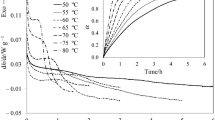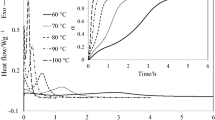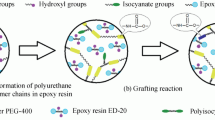Abstract
The kinetics of the epoxy–amine polycondensation and the epoxy homopolymerization in off-stoichiometric epoxy/amine formulations with excess of epoxy groups, and in the presence of an anionic initiator have been investigated. Diglycidyl ether of bisphenol A (DGEBA) and diethylenetriamine (DETA) have been used as epoxy and amine reagents, respectively, and 2-methylimidazole (2MI) has been used as anionic initiator. This study has been carried out using a differential scanning calorimeter (DSC). The thermal–mechanical properties of the partially cured and fully cured materials with and without initiator have been determined by DSC and dynamic-mechanical analysis. First, off-stoichiometric DGEBA/DETA mixtures with excess of DGEBA, with and without 2MI, have been reacted isothermally at low temperatures, where only the epoxy–amine condensation takes place, because the epoxy homopolymerization has a very low curing rate. Afterward, samples containing 2MI have been heated at different heating rates to study the homopolymerization process of the epoxy excess. The kinetics of both processes have been analyzed with an isoconversional method to determine the activation energy, and the Šesták–Berggren equation has been applied to determine the frequency factor and the orders of reaction. In the isothermal curing, amine–epoxy condensation, the activation energy and the frequency factor decrease with increasing degree of conversion, but in the homopolymerization process, both magnitudes increase with the degree of conversion. Results show that the dual-curing character of off-stoichiometric DGEBA/DETA thermosets with 2MI as anionic initiator renders them suitable for multistage curing processes in which the degree of cure and material properties in the intermediate stage can be controlled easily and final material properties can be enhanced.







Similar content being viewed by others
References
Riew CK, Siebert AR, Smith RW, Fernando M, Kinloch AJ. Toughened epoxy resins: performed particles as tougheners for adhesives and matrices. In: Riew CK, Kinloch AJ, editors. Toughened plastics II novel approaches in science and engineering. Advances in Chemical Series, vol. 252. Washington: American Chemical Society; 1996. p. 33–44.
Saiki N, Yamazaki O, Ebe K. UV/heat dual-curable adhesive tapes for fabricating stacked packages of semiconductors. J Appl Polym Sci. 2008;108:1178–83.
Kang B-U. Interfacial fracture behavior of epoxy adhesives for electronic components. J Korea Acad Ind Cooper Soc. 2011;12:1479–87.
May CA, Tanaka GY. Epoxy resins. In: May CA, editor. Chemistry and technology, Chap. 1. New York: Marcel Dekker; 1988.
Petrie EM. Epoxy adhesive formulations. New York: McGraw-Hill; 2006.
Pascault JP, Williams RJJ. Epoxy polymers: new materials and innovations. Weinheim: Wiley-VCH; 2010.
Kinloch AJ, Shaw SJ, Tod DA, Hunston DL. Deformation and fracture behavior of a rubber-toughened epoxy: 1. Microstructure and fracture studies. Polymer. 1983;24:1341–54.
Ho T-H, Wang C-S. Toughening of epoxy resins by modification with dispersed acrylate rubber for electronic packaging. J Appl Polym Sci. 1993;50:477–83.
Mezzenga R, Boogh L, Månson JAE. A review of dendritic hyperbranched polymer as modifiers in epoxy composites. Compos Sci Technol. 2001;61:787–95.
Guo QP, Habrard A, Park Y, Halley PJ, Simon GP. Phase separation, porous structure, and cure kinetics in aliphatic epoxy resin containing hyperbranched polyester. J Polym Sci B. 2006;44:889–99.
Ratna D, Varley R, Simon GP. Toughening of trifunctional epoxy using an epoxy-functionalized hyperbranched polymer. J Appl Polym Sci. 2003;89:2339–45.
He S, Shi K, Bai J, Zhang Z, Li L, Du Z, Zhang B. Studies on the properties of epoxy resins modified with chain-extended ureas. Polymer. 2001;42:9641–7.
Zhou L, Zhang G, Li J, Jing Z, Qin J, Feng Y. The flame retardancy and thermal stability properties of flame-retarded epoxy resins based on α-hydroxyphosphonate cyclotriphosphazene. J Therm Anal Calorim. 2017;129:1667–78.
Mao W, Li S, Yang X, Cao S, Li M, Huang K, Xia J. Preparation of a flame-retardant epoxy curing agent based on castor oil and study on the curing reaction kinetics. J Therm Anal Calorim. 2017;130:2113–21.
Evans D, Canfer SJ. Radiation stable, low viscosity impregnating resin systems for cryogenic applications. Adv Cryog Eng. 2000;46:361–8.
Ueki T, Nishijima S, Izumi Y. Designing of epoxy resin systems for cryogenic use. Cryogenics. 2005;45:141–8.
Nishijima S, Honda Y, Okada T. Application of the positron annihilation method for evaluation of organic materials for cryogenic use. Cryogenics. 1995;35:779–81.
Pascault JP, Sautereau H, Verdu J, Williams RJJ. Thermosetting polymers. 1st ed. New York: Marcel Dekker, Inc.; 2002.
Thanki JD, Parsania PH. Dynamic DSC curing kinetics and thermogravimetric study of epoxy resin of 9,9′-bis-(4-hydroxyphenyl)anthrone-10. J Therm Anal Calorim. 2017;130:2145–56.
Fernández-Francos X, Santiago D, Ferrando F, Ramis X, Salla JM, Serra A, Sangermano M. Network structure and thermomechanical properties of hybrid DGEBA networks cured with 1-methylimidazole and hyperbranched poly(ethyleneimine)s. J Polym Sci Part B Polym Phys. 2012;50:1489–503.
Leena K, Soumyamol PB, Baby M, Suraj S, Rajeev R, Mohan DS. Non-isothermal cure and decomposition kinetics of epoxy–imidazole systems. J Therm Anal Calorim. 2017;130:1053–61.
Ramis X, Fernández-Francos X, De La Flor S, Ferrando F, Serra À. Click-based dual-curing thermosets. In: Guo Q, editor. Thermosets: structure, properties and applications, Chapter 9. 2nd ed. Amsterdam: Elsevier; 2017.
Fernández-Francos X, Konuray AO, Belmonte A, De la Flor S, Serra A, Ramis X. Sequential curing of off-stoichiometric thiol–epoxy thermosets with a custom-tailored structure. Polym Chem. 2015;7:2280–90.
González G, Fernández-Francos X, Serra À, Sangermano M, Ramis R. Environmentally-friendly processing of thermosets by two-stage sequential aza-Michael addition and free-radical polymerization of amine–acrylate mixtures. Polym Chem. 2015;6:6987–97.
Nair DP, Cramer NB, Gaipa JC, McBride MK, Matherly EM, McLeod RR, Shandas R, Bowman CN. Adv Funct Mater. 2012;22:1502–10.
Tech Tip 20. B-stage epoxy. In: Epo-tek tech tips. Epoxy technology. 2012. http://www.epotek.com/site/files/Techtips/pdfs/tip20.pdf. Accessed 21 July 2014.
Vyazovkin S, Burnham AK, Criado JM, Pérez-Maqueda LA, Popescu C, Sbirrazzuoli N. ICTAC Kinetics Committee recommendations for performing kinetic computations on thermal analysis data. Thermochim Acta. 2011;520:1–19.
Ooi SK, Cook WD, Simon GP, Such CH. DSC studies of the curing mechanisms and kinetics of DGEBA using imidazole curing agents. Polymer. 2000;41:3639–49.
Fernández-Francos X, Cook WD, Serra À, Ramis X, Liang GG, Salla JM. Crosslinking of mixtures of DGEBA with 1,6-dioxaspiro[4,4]nonan-2,7-dione initiated by tertiary amines. Part IV. Effect of hydroxyl groups on initiation and curing kinetics. Polymer. 2010;51:26–34.
Flores M, Fernández-Francos X, Ramis X, Serra A. Novel epoxy-anhydride thermosets modified with a hyperbranched polyester as toughness enhancer. Thermochim Acta. 2012;544:17–26.
Santiago D, Fernández-Francos X, Ramis X, Salla JM, Sangermano M. Comparative curing kinetics and thermal-mechanical properties of DGEBA thermosets cured with a hyperbranched poly(ethylenimine) and an aliphatic triamine. Thermochim Acta. 2011;526:9–21.
Acebo C, Fernández-Francos X, Ferrando F, Serra À, Ramis X. New epoxy thermosets modified with multiarm star poly(lactide) with poly(ethyleneimine) as core of different molecular weight. Eur Polym J. 2013;49:2316–26.
Acknowledgements
The authors would like to thank MINECO (Ministerio de Economía y Competividad) and FEDER (Fondo Europeo de Desarrollo Regional) (MAT2014-53706-C03-01, MAT2014-53706-C03-02 and MAT2017-82849-C2-2-R) and to the Comissionat per a Universitats i Recerca del DIUE de la Generalitat de Catalunya (2014-SGR-67). Xavier F.-F. acknowledges the Serra Hunter programme of the Generalitat de Catalunya.
Author information
Authors and Affiliations
Corresponding author
Rights and permissions
About this article
Cite this article
Morancho, J.M., Ramis, X., Fernández-Francos, X. et al. Curing of off-stoichiometric amine–epoxy thermosets. J Therm Anal Calorim 133, 519–527 (2018). https://doi.org/10.1007/s10973-018-7158-2
Received:
Accepted:
Published:
Issue Date:
DOI: https://doi.org/10.1007/s10973-018-7158-2




